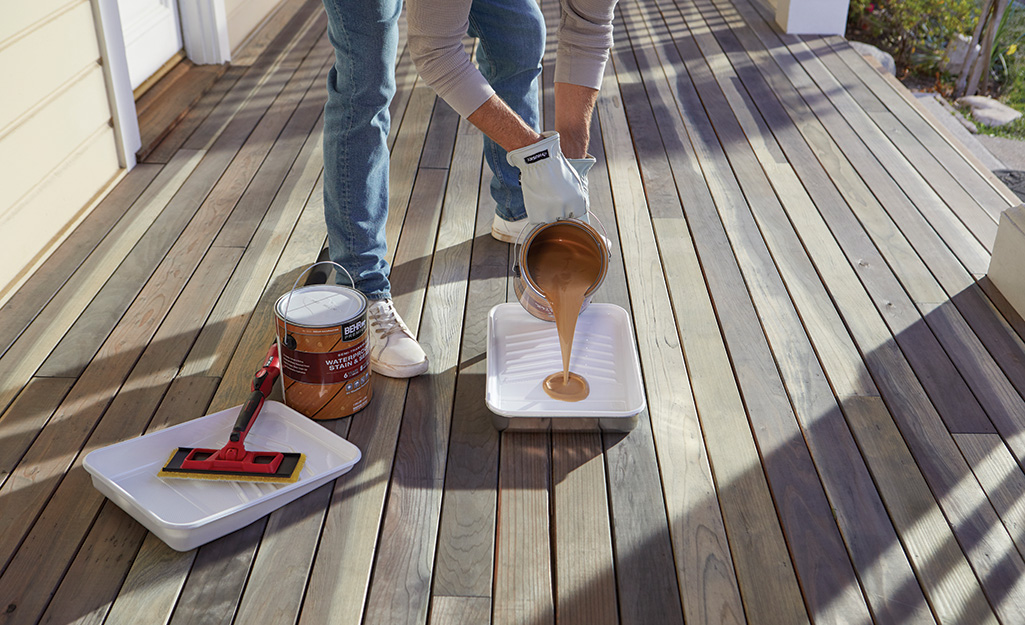Guardians of Timber: Fence Staining Masters at Your Service
Guardians of Timber: Fence Staining Masters at Your Service
Blog Article
Do It Yourself Fencing Staining: Step-by-Step Directions to Revitalize Your Exterior Area
Are you aiming to rejuvenate your outdoor area? One effective way to renew your fence and improve the visual allure of your residential property is by discoloring it. DIY Fencing Staining: Step-by-Step Recommendations to Renew Your Outdoor Space gives you with a comprehensive overview to accomplishing professional-looking outcomes by yourself. This step-by-step overview will certainly stroll you via the whole process, from gathering the required materials to preserving and safeguarding your recently tarnished fence. By complying with these guidelines, you can change your dull and weathered fence into a magnificent focal point that adds worth to your home. Bid farewell to an uninspired outside room and hi to a renewed and vivid setting. Prepare to take your DIY skills to the following level with our overview to fencing discoloration.
Gather the Necessary Products
To collect the needed products for do it yourself fencing staining, start by constructing a detailed list of products required for the project. This checklist must consist of the adhering to items:
Stain: Select a high-grade tarnish that is especially developed for exterior usage. Think about elements such as shade, weather, and durability resistance when choosing the tarnish for your fencing.
Brushes or Rollers: Depending on the size and appearance of your fence, you might require both brushes and rollers. Brushes are optimal for getting to into dilemmas and crevices, while rollers are more reliable for larger, level locations.
Drop Cloths or Tarps: Secure your surrounding locations from accidental spills or splatters by covering them with decline towels or tarpaulins. This will certainly help prevent any type of damage to your grass, plants, or other outside furniture.
Cleansing Materials: Before tarnishing your fence, it's important to clean it completely. Collect items such as a power washer, scrub brush, and a moderate cleaning agent to eliminate any debris, gunk, or dust.
Safety Equipment: Do not neglect to focus on safety and security while servicing your fence. Wear protective safety glasses, handwear covers, and a mask to secure yourself from any type of possible threats, such as fumes or chemicals.
Prepare the Fencing for Staining
To prepare the fence for staining, extensively tidy the surface area using a power washing machine, scrub brush, and light cleaning agent to remove any kind of crud, dirt, or particles. This step is crucial to guarantee that the stain sticks properly to the fencing and offers a smooth and even complete.
Begin by utilizing a power washer to get rid of any loosened dirt or debris from the fencing. Set the pressure to a moderate level to prevent harming the timber (fence cleaning). Move the power washer in a sweeping motion, working from top to bottom, to guarantee detailed cleansing
Following, make use of a scrub brush and light detergent to scrub the fencing. This will certainly assist eliminate any type of continuing to be dust or gunk that the power washer may have missed out on. Work in tiny areas, applying mild stress to avoid damaging the timber. Rinse the fence completely with water to get rid of any type of cleaning agent deposit.
After cleaning, permit the fencing to completely dry totally before waging the discoloration process. This is necessary to guarantee that the tarnish is soaked up appropriately by the timber. Depending on the weather condition problems, this might take anywhere from a few hours to a pair of days.
Apply the Stain to the Fencing
To begin the discoloration process, carefully apply the discolor to the prepared fence utilizing a roller, brush, or sprayer , ensuring also protection and smooth application. This step is essential in accomplishing a professional-looking surface and improving the sturdiness of your fencing.

If you like to make use of a roller, pick one with a tool nap for optimum tarnish absorption. Pour the stain into a roller tray and roll the roller backward and forward to fill it uniformly. Beginning at the top of the fencing and roll the stain onto the surface, overlapping each stroke somewhat for regular protection.
For larger areas or to accelerate the process, a sprayer can be utilized. Fill the sprayer with the tarnish according to the maker's guidelines and readjust the nozzle for a fine mist or spray pattern. Hold the sprayer about 6-8 inches far from the fencing and use the stain in a sweeping motion, moving from side to side and top to base.
No matter of the application approach selected, take treatment to prevent drips, runs, or pooling of the discolor. Work carefully and methodically, guaranteeing that each section receives appropriate insurance coverage. Once the discolor has actually been used, allow it to dry totally according to the maker's suggested drying out time before applying a 2nd coat if preferred.
Allow the Spot Dry and Remedy
After using the discolor to the fence, it is necessary to enable it to completely dry and treatment totally before continuing with any type of additional steps. Permitting the discolor to dry and cure makes certain that it adheres effectively to the timber surface area, offering long-lasting defense and an attractive surface.

To promote proper drying out, it is advised to leave the fence untouched and prevent any kind of contact with the tarnished surface. This indicates avoiding leaning items versus the fencing or brushing against it. Doing so can potentially disrupt the result and discolor in an irregular surface.
Once the tarnish has dried completely, it is necessary to enable it to treat. Curing is the process in which the tarnish totally hardens and sets, supplying optimum longevity and defense. This normally takes around 2 to 3 weeks, depending upon the kind of tarnish used. During this time, it is recommended to avoid any activities that may cause damages to the fresh tarnished fencing, such as hanging designs or leaning heavy things versus it.
Maintain and Shield Your Recently Discolored Fence
On a regular basis evaluate and preserve your newly stained fencing to guarantee its resilient appeal and security - deck staining. While the discoloration process enhances the appearance and longevity of the fencing, it is vital to take proper treatment to preserve its high qualities in time. Here are some pointers to maintain and safeguard your newly discolored fencing
Firstly, routinely inspect your fencing for any type of indications of damage or wear. Look for cracks, peeling off, or staining, as these can show issues that need to be addressed without delay. If you observe any troubles, take instant action to protect against additional damages.
Following, maintain your fence clean by consistently getting rid of dust, particles, and stains. Utilize a soft brush and a mild cleaning agent or sponge to delicately scrub the surface. Prevent making use of rough chemicals or abrasive materials that might linked here harm the tarnish.
Furthermore, trim any kind of greenery that grows near the fence to avoid it from rubbing against the surface, which can cause scrapes or damage the tarnish. It is likewise essential to ensure correct water drainage around the fencing to stop water from causing and pooling rot or degeneration.
Lastly, take into consideration using a safety sealant or overcoat to offer an extra layer of security versus the elements. This can help extend the life of the stain and preserve the fence's beauty.
Verdict
In conclusion, by following these detailed guidelines, you can rejuvenate your outside area via DIY fencing discoloration. Collecting the essential materials, preparing the fencing, applying the stain, and enabling it to completely dry and treatment are vital for achieving a perfectly tarnished fencing. Additionally, maintaining and protecting your recently stained fence will certainly aid it last longer and continue to improve your exterior location.
Usage long, even strokes to spread out the discolor uniformly, making sure to cover all surfaces, consisting of the tops and bases of the fencing boards.
Hold the sprayer around 6-8 inches away from the fence and apply the discolor in a sweeping motion, moving from side to side and top to base.
To advertise appropriate drying out, it is suggested to leave the fence unblemished and prevent any type of contact with the stained surface. Gathering the essential materials, preparing the fencing, using the tarnish, and allowing it to dry and treatment are necessary for accomplishing a perfectly discolored fencing. Additionally, preserving and securing your freshly stained fence will certainly aid it last much longer and continue to improve your exterior location.
Report this page